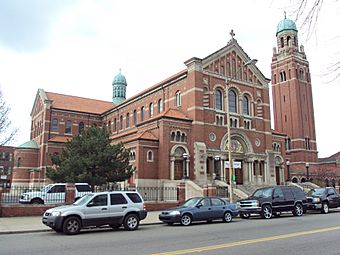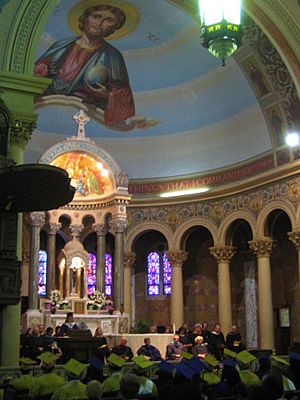Most Holy Redeemer Church (Detroit) facts for kids
Quick facts for kids |
|
|
Most Holy Redeemer Church
|
|
|
U.S. Historic district
Contributing property |
|
 |
|
| Location | 1721 Junction Street Detroit, Michigan |
|---|---|
| Built | 1921 |
| Architect | Donaldson and Meier |
| Architectural style | Renaissance Revival |
| Part of | West Vernor–Junction Historic District (ID02001503) |
| MPS | West Vernor Highway Survey Area, Detroit, Michigan MPS |
| Added to NRHP | December 12, 2002 |
The Most Holy Redeemer Church is a very old and important church. It is located at 1721 Junction Street in Southwest Detroit, Michigan. This church is part of a special area called the West Vernor–Junction Historic District. It was once thought to be the biggest Roman Catholic church in all of North America! The area around the church is close to Mexicantown. It has a growing Mexican community, making the neighborhood lively and strong.
Contents
A Look Back: The Church's History
The Most Holy Redeemer Church started in 1880. It was founded by a priest named Aegidius Smulders. He was a Redemptorist father, which means he belonged to a special group of Catholic priests.
At first, the church mainly served Irish immigrants. Many of these people worked in tobacco factories nearby. Early church services were held in unusual places. They met above a general store and later in a saloon. The first floor of the saloon was for services, and priests lived upstairs.
Early Church Buildings
The very first church building was made of wood. It was designed by a Redemptorist Brother named Thomas. People called it the "Little Church on Sand Hill." It was officially opened in 1881.
Later, in 1896, a second, larger church was built. This one was in the Gothic style. It was built when Benedict Neithart was the pastor.
Changes Over Time
As time passed, many Irish and German families moved away. People of Latin American descent began to move into the area. They came from the Corktown area of Detroit. Because of this change, the church started offering a mass in Spanish in 1960.
In 1999, the Redemptorist priests handed over the church. It became part of the Roman Catholic Archdiocese of Detroit. The church also has a school. The parish school was started in 1882 by the Sisters of the Immaculate Heart of Mary. More recently, in 2017, the Sisters of the Society of Our Lady of the Most Holy Trinity (SOLT) came to help at the school and church. Young men studying to become priests, called SOLT Seminarians, also live at the parish. They study at a nearby seminary.
Church Design: Architecture
The current church building was finished in 1921. It was officially opened on April 1, 1923. The famous architecture firm Donaldson and Meier designed it.
Building Style
The church was built in the Roman basilica style. This means it has a long, rectangular shape like ancient Roman buildings. It also has a Romanesque front, which is a style known for its round arches and strong walls. The church is very large and can seat about 1,400 people.
Around 1924, a tall bell tower, called a campanile, was added. It was built to remember the church members who died in World War I.
Special Features
The church has beautiful stained glass windows. The windows along the aisles were designed by Charles Jay Connick. The windows on the south side show stories from the Bible called parables. The windows on the north side show miracles.
The windows higher up, called clerestory windows, were made by the Detroit Stained Glass Works. The roof of the church is covered with special Ludowici tiles. Inside, the floor has a unique mosaic tile design. It was created by Mary Chase Perry Stratton using Pewabic tiles.
About the Parish and Neighborhood
The Most Holy Redeemer parish is home to a long-standing elementary school. It also hosts the Detroit Cristo Rey High School. This high school has been operating since 2008. It is located inside the building of the former Holy Redeemer High School.
The church is in Southwest Detroit. Like other neighborhoods there, West Vernor Highway is the main street for shops and businesses. Churches, parks, recreation centers, and theaters are important parts of these neighborhoods. The Most Holy Redeemer parish is a very important landmark at the West Vernor-Junction intersection.
See also
 In Spanish: Iglesia del Santísimo Redentor para niños
In Spanish: Iglesia del Santísimo Redentor para niños
- Architecture of metropolitan Detroit
- Roman Catholic Archdiocese of Detroit


